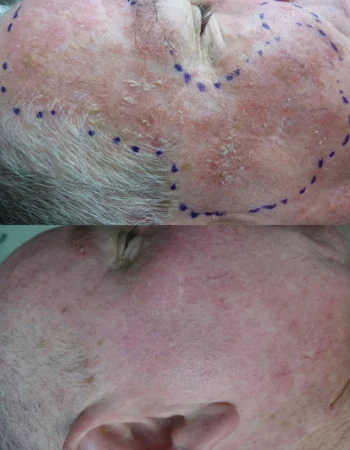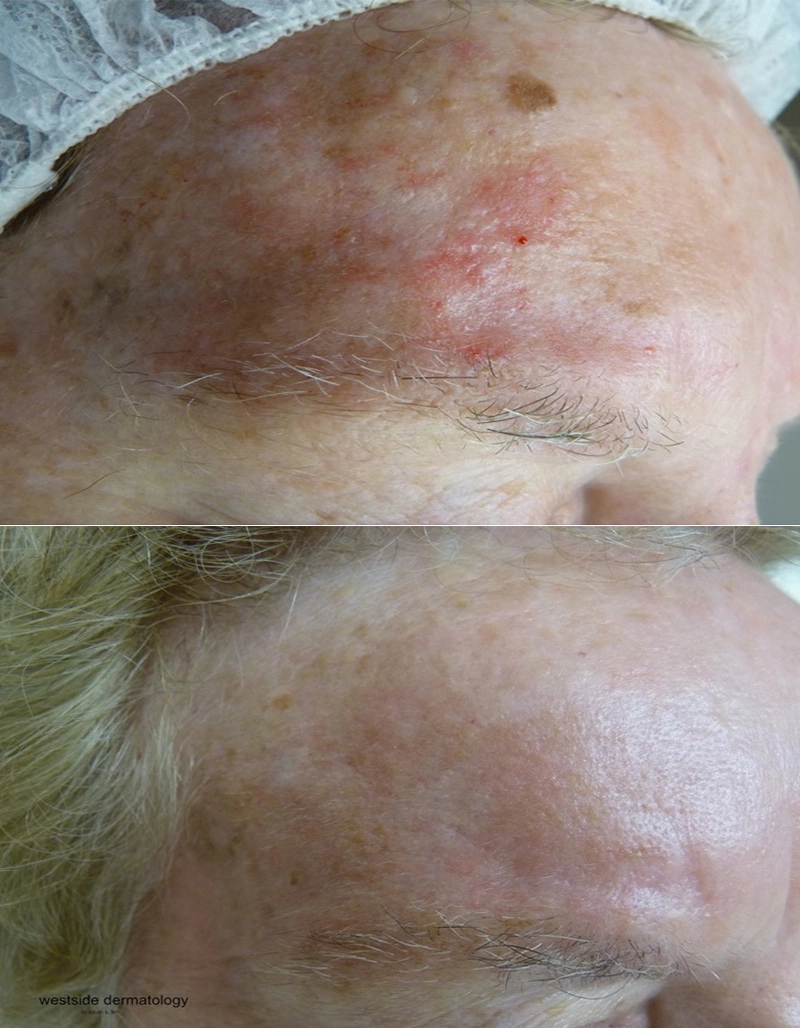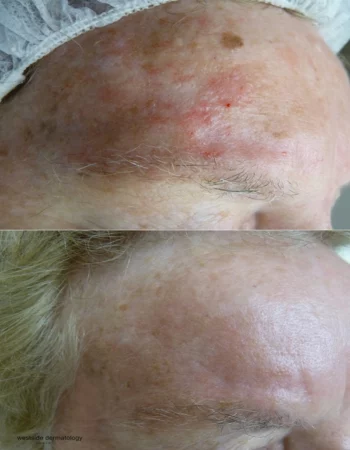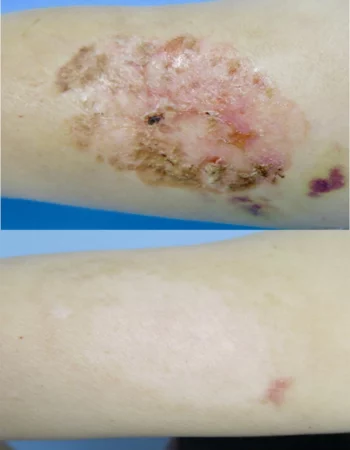Cutis Dermatology is home to Brisbane’s leading dermatologists who are experts in skin cancer screening, prevention and treatment. We are committed to diagnosing and treating skin cancer in our Brisbane clinics and have a Rapid Access Skin Help or RASH service. Urgent cases, including skin cancer diagnosis are seen within 48 hours.
Learn more about what types of skin cancer we treat.
- Basal Cell Cancers
- Squamous Cell Cancers
- Mole Checks
- Mole Removal
- Seborrhoeic Keratosis
Our results speak for themselves

Before
After

Photodynamic Therapy, thulium assisted
for solar keratosis. PDT is covered under
DVA
Ask us more about this treatmant
Preferred Consultation

Before
After

Photodynamic therapy, 2 sessions
Ask us more about this treatmant
Preferred Consultation

Before
After

PDT therapy for skin cancer
Ask us more about this treatmant
Preferred Consultation
Types of skin cancer we treat
How can a dermatologist assist?
Cancer skin checks Brisbane
Dermatologists are the experts in skin cancer screening, prevention & treatment. We undergo an additional four years of skin cancer training in a tertiary hospital. Our experience, knowledge & skill sets enable us to deal with all types of cancers, from simple sunspots & basal cell carcinomas to multiple dysplastic moles & unusual tumors.
Skin cancer is the most common form of cancer in Australia.
The high UV index in Queensland damages skin cells. Having your skin checked regularly gives you peace of mind. Early detection saves lives.
If you do have a suspected skin cancer, a prompt proactive approach often leads to less invasive treatments & better outcomes.
Photodynamic Therapy is a non-surgical treatment for skin cancer
Early treatment of sun damage reduces skin cancers
PDT uses the power of clinically prescribed low level laser light to treat superficial skin cancers & sun damage. A light sensitive gel is absorbed by cancer cells, followed by activation using special light sources. PDT is ascarless & painless way of treating thin skin cancers.
Brisbane has one of the highest rates of pre-cancerous solar or actinic keratosis in the world. Dermatologists employ creams, chemical peels & lasers to effectively treat sun spots with minimal downtime.
Dermatologists are the experts in skin cancer screening, prevention & treatment. We apply surgical as well as non-surgical methods including laser assisted photodynamic therapy, fractional & ablative lasers to address pre-cancer & cancerous lesions.
FAQs
Why choose Cutis Dermatology Brisbane for your skin cancer checks?
Having an experienced dermatologist is important especially when you have a chronic skin condition that will require ongoing treatment. Our consultants have years of private practice & have dedicated their time teaching trainee dermatologists in public hospitals in Brisbane.
We perform all facets of skin cancer work, from screening, prevention through to surgical intervention.
Cutis Dermatology is conveniently located in the Western suburbs of Brisbane. We have two surgical theatres & 9 laser suites. Urgent cases are seen within 72 hours.
How do dermatologists manage skin cancers?
Treatment depends on the type of skin cancer you may have. We also factor in location of the lesion, your age & risk factors. Our consultant dermatologist will assess your skin and advise on the best course of treatment, including-
- Surgical excision
- Curettage and electrocautery
- Cryotherapy
- Anti-Cancer Creams
- Laser therapy
- Photodynamic Therapy (PDT)
- Micrographic Surgery (MOHS)
- Radiotherapy
- Combination treatments
How often should you have your skin checked?
Be guided by your dermatologist. The frequency of checks depends on your risk factors.
High risk patients are seen every 3 months. They include a previous history of melanoma within the past 2 years, as well as immune suppression.
Moderate risk patients are seen at 6–12-month intervals. This includes a family history of melanoma, multiple dysplastic moles & a history of numerous non-melanoma skin cancer.
Low risk patients are seen every 1-2 years. This includes patients with a history or UV exposure without any history of melanoma/skin cancer.
What to look for when performing a self-examination?
It is a good idea to check your moles every 6 to 8 weeks. It’s especially important if you have multiple moles, & even more so if you have a family or personal history of skin cancers.
Use both a full length & handheld mirror. Remember to check your scalp, the soles & in between your fingers & toes. Pay close attention to any changes in the growth of moles, their outline & colours. Symptoms such as itching, bleeding or crusting of moles may point to early change.
What to do if you notice a suspicious lesion?
If you are an existing patient of Cutis Dermatology, inform reception of your concerns. They can often get you in to see your dermatologist within a day or two.
If you have not got a dermatologist, your GP may help. If suspicious, your family physician will raise an urgent appointment to see one of our specialists. In most cases you will be seen within 48 hours.
What causes skin cancer?
Ultraviolet radiation is the most well-known cause of skin cancer. With Brisbane’s high UV index, 2 out of 3 Queenslanders will develop skin cancer at some stage of life.
People with paler skin are at a higher risk of developing skin cancer as they are more vulnerable to damage from the sun’s ultraviolet (UV) rays. If you have many moles, this increases your melanoma rate.
A family history of melanoma or non-melanoma skin cancer also increases your rate of developing skin cancer.
Dermatologists also see high risk skin cancer groups including immune suppressed patients.
What signs should you look out for in moles?
Similar moles are a good sign, whilst a standout mole may herald a more sinister event.
When performing a self-examination, you are looking for any changes to the size, colour & shape. A simple rule is the ABCDE.
- A Asymmetry – one half is not the mirror image of the other
- B Borders – the mole has borders that are uneven
- C Colour – there are multiple colours within the mole (brown, tan or black)
- D Diameter – the mole grows larger than a pencil eraser (¼ inch)
- E Evolution – the mole evolves in size, shape, colour, elevation, or there is a new characteristic
What are examples of rare skin cancers seen by dermatologists?
Inherently, dermatologists are skin geeks, we love to manage rare skin conditions, including skin cancers. At Cutis Dermatology we see skin cancers that are not within the scope of skin cancer GPs. Tumors include-
- Atypical fibroxanthomas
- Dermatofirbroscarcomas
- Angiosarcomas
- Lymphangioscarcomas
- Merkel cell cancers
- Sebaceous carcinomas
- Cutaneous metastasis
- Cutaneous B cell lymphomas
- Cutaneous T cell lymphomas; mycosis fungoides
- PLEVA & undifferentiated cutaneous tumours
What things can you do to reduce the rate of skin cancers?
You can undertake some lifestyle choices that can reduce the rate of skin cancer formation, including-
- Being sun smart. SPF 50+ twice a day. Use a daily sunscreen as well as an activity waterproof one for sport & activities.
- Reduce or eliminating smoking will markedly reduce the chances of getting lip cancer, namely the SCC of the lip.
- Dietary supplementation of vitamin B3 can potentially reduce some skin cancers including basal & squamous cell cancers.
- Diet changes are controversial. There is some evidence that a diet high in an antioxidant diet can reduce sun damage. This study involved patients from Brisbane, & the sunshine coast


